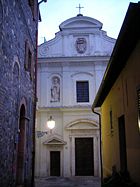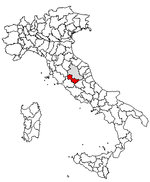
Cesi
Encyclopedia


Frazione
A frazione , in Italy, is the name given in administrative law to a type of territorial subdivision of a comune; for other administrative divisions, see municipio, circoscrizione, quartiere...
of the Italian comune
Comune
In Italy, the comune is the basic administrative division, and may be properly approximated in casual speech by the English word township or municipality.-Importance and function:...
of Terni
Terni
Terni is a city in southern Umbria, central Italy, capital of the province of Terni, located in the plain of the Nera river. It is 104 km N of Rome, 36 km NW of Rieti, and 29 km S of Spoleto.-History:...
, in the province of Terni
Province of Terni
The Province of Terni is the smaller of the two provinces in the Umbria region of Italy, comprising one-third of both the area and population of the region. Its capital is the city of Terni...
, southern Umbria
Umbria
Umbria is a region of modern central Italy. It is one of the smallest Italian regions and the only peninsular region that is landlocked.Its capital is Perugia.Assisi and Norcia are historical towns associated with St. Francis of Assisi, and St...
, Italy. The small borgo, which retains its late-medieval aspect, set among olive groves, lies "stretched out lengthwise along a narrow contour on the slopes of M. Torre Maggiore," about 18 km north of Terni at an altitude of 437 m, one of the southernmost peaks of the Monti Martani. As of 2001 there were 682 residents.
History
Testaments to the likely UmbriUmbri
The Umbri were an Italic people of ancient Italy. A region called Umbria still exists and is currently occupied by Italian speakers. It is somewhat smaller than the ancient Umbria....
an origin of the site of Clusiolum are remains of walling slightly below the present village. Above it, near the peak of the Torre Maggiore (1121 m.) are the remains of an Italic
Ancient Italic peoples
Ancient people of Italy are all those people that lived in Italy before the Roman domination.Not all of these various people are linguistically or ethnically closely related...
religious complex dating to the sixth century BCE, brought to light by an excavation.
The name Cesi derives from Late Latin
Late Latin
Late Latin is the scholarly name for the written Latin of Late Antiquity. The English dictionary definition of Late Latin dates this period from the 3rd to the 6th centuries AD extending in Spain to the 7th. This somewhat ambiguously defined period fits between Classical Latin and Medieval Latin...
caesa, a place cleared of woodland.
In the Middle Ages Cesi was a fief of the Arnolfi, the chief seat of the Terre Arnolfe. The family claimed descent from the Lombard
Lombards
The Lombards , also referred to as Longobards, were a Germanic tribe of Scandinavian origin, who from 568 to 774 ruled a Kingdom in Italy...
Arnulf, who established himself in the region. The noble family of Cesi, dukes of Aquasparta, derive their name from this place. Of this family was Federico Cesi
Federico Cesi
Federico Angelo Cesi was an Italian scientist, naturalist, and founder of the Accademia dei Lincei. On his father's death in 1630, he became briefly lord of Acquasparta.- Biography :...
, founder of the Accademia dei Lincei
Accademia dei Lincei
The Accademia dei Lincei, , is an Italian science academy, located at the Palazzo Corsini on the Via della Lungara in Rome, Italy....
, Rome.
During 10-14 July 1849, Garibaldi encamped here, on his retreat from Rome after the fall of the revived Roman Republic
Roman Republic (19th century)
The Roman Republic was a state declared on February 9, 1849, when the government of Papal States was temporarily substituted by a republican government due to Pope Pius IX's flight to Gaeta. The republic was led by Carlo Armellini, Giuseppe Mazzini and Aurelio Saffi...
.
Places of interest
- At San Erasmo above the village there is an astronomical observatory.
- Church of S. Michele Arcangelo (1080), a Romanesque churchRomanesque architectureRomanesque architecture is an architectural style of Medieval Europe characterised by semi-circular arches. There is no consensus for the beginning date of the Romanesque architecture, with proposals ranging from the 6th to the 10th century. It developed in the 12th century into the Gothic style,...
partly rebuilt in the thirteenth century with four pointed arches supporting its roof, now the site of the annual concerts of the Settembre musicale cesano. - Palazzo Contelori, former seat of the suppressed commune now joined to Terni; irt was partly rebuilt in the seventeenth century.
- Church of S. Andrea (1160), with fragments of carved funeral reliefs from Roman CarsulaeCarsulaeCarsulae is an archaeological site in Umbria, central Italy, now one of the most important archaeological ruins in Italy. It is located c. 4 km north of San Gemini, a small comune in the province of Terni. Nearby is the comune of Montecastrilli .-Origins and history:Most historians fix the...
embedded in the façade; the entrance is through a door in the long side; there is a second, smaller, porta del morto through which coffins were carried not to bring ill-omen on the usual entrance. Palazzo Cesi faces the church. - Parish church of S. Maria Assunta (sixteenth-seventeenth centuries); altarpiece of Madonna and Child with Saints (dated 1308) by the anonymous Master of CesiAnonymous mastersIn the history of art and architecture, an anonymous master is an architect, Old Master painter, or printmaker whose work is known, but whose name is not.-Pre-Renaissance:...
, and a detached fresco Madonna and Child by Tommaso Papacello da Cortona (1538). - Palazzo Cittadini-Cesi (sixteenth century);
- Medieval city walls and watchtowers.
- Umbrian archways (sixth-fifth centuries BCE)
- The little Church (Chiesetta) of S. Erasmo, in Romanesque style; it was founded by the Benedictines in the twelfth century.
- Palazzo Stocchi, from which there is access to the grotta Eolia.
- Palazzo Eustachi.
- Church of Sant'Onofrio.

